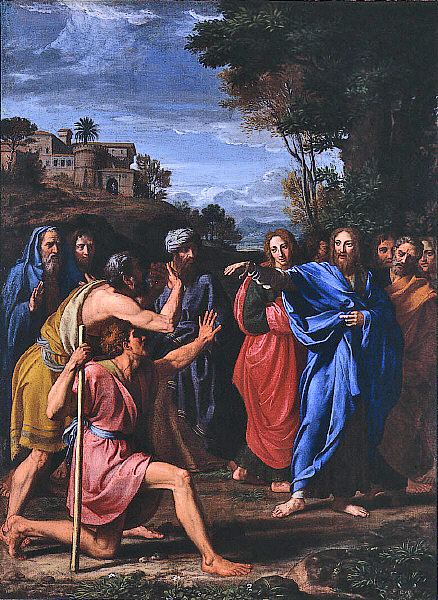Order in the Bible part 4 | ||
 | ||
John 9 is the ninth chapter of the Gospel of John in the New Testament of the Christian Bible. It records the healing of a man who had been blind from birth, a miracle performed by Jesus, and their subsequent dealings with the Pharisees. The book containing this chapter is anonymous, but early Christian tradition uniformly affirmed that John composed this Gospel.
Contents
Text
Structure
The New King James Version organises this chapter as follows:
Location
Jesus and His disciples are said to be "passing by" and there is no indication yet that they have left Jerusalem, the scene of the narrative in chapters 7 and 8. Jesus sends the man He heals to the Pool of Siloam, a rock-cut pool on the southern slope of Jerusalem, located outside the walls of the Old City to the southeast. However, there are also references to a Jewish ruling that anyone who believed Jesus to be the Messiah would be excluded from the synagogue (John 9:22). There is no other New Testament reference to Jerusalem having a synagogue, but rabbinical tradition states that there were 480 synagogues in Jerusalem at the time of the Jewish rebellion.
Chronology
The initial events of this chapter occur on a Sabbath (John 9:14), not necessarily connected with the Feast of Tabernacles or the days immediately afterwards when the events of John 7-8 took place. Anglican Bishop Charles Ellicott suggests that this was the last day, the "great day" of the Feast of Tabernacles referred to in John 7:37 because "nothing has taken place which makes it necessary to suppose any interval, and though the discourses seem long, they would have occupied but a short time in delivery" and the Pulpit Commentary agrees that "the day may have been a festival sabbath".
Verse 22
The Jews had agreed already that if anyone confessed that He (Jesus) was Christ, he would be put out of the synagogue (New King James Version). "The word for ‘out of the synagogue’ (Greek: ἀποσυνάγωγος) is peculiar to S. John, occurring John 12:42, John 16:2, and nowhere else". It is out of place in the context of a healing taking place in the Temple in Jerusalem. The decision has been linked to the possible Council of Jamnia which was once thought to have decided the content of the Jewish canon sometime in the late 1st century (c. 70–90).
Verse 39
New King James Version
And Jesus said, “For judgment I have come into this world, that those who do not see may see, and that those who see may be made blind.”